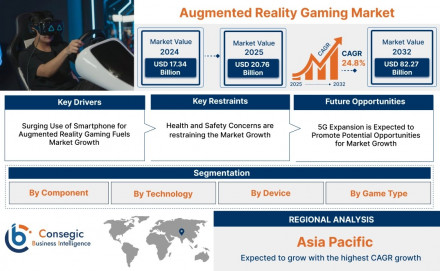Augmented Reality Gaming Market Suppliers and Distributors Overview (2025-2032)

Augmented Reality Gaming Market Size:
Augmented Reality Gaming Market size is estimated to reach over USD 82.27 Billion by 2032 from a value of USD 17.34 Billion in 2024 and is projected to grow by USD 20.76 Billion in 2025, growing at a CAGR of 24.8% from 2025 to 2032.
Augmented Reality Gaming Market Overview:
The augmented reality gaming market is rapidly evolving, driven by the widespread use of smartphones and advancements in AR development platforms. Blending digital content with real-world environments, AR games offer immersive and interactive experiences that appeal to a broad audience. The market is expanding with contributions from both established gaming companies and innovative startups. Integration with technologies like 5G, AI, and cloud computing is enhancing game quality and user engagement. As consumer interest in immersive entertainment grows, AR gaming is set to become a key segment in the future of digital gaming.
Augmented Reality Gaming Market Includes Drivers, Restraints & Opportunities
Drivers:
- Technological Advancements: Improvements in AR hardware (e.g., smart glasses, haptic devices) and software development kits (SDKs) have enabled more sophisticated and immersive gameplay experiences.
- Mobile Penetration: The widespread use of smartphones with high-resolution cameras and powerful processors has made AR gaming more accessible.
- 5G Deployment: Faster and more reliable network connections enhance real-time interaction in AR games, reducing Consumer Demand for Immersive Experiences: Gamers are increasingly seeking novel, engaging, and interactive experiences that go beyond traditional screen-based gaming.
- Marketing and Branding: Brands are adopting AR gaming as a promotional tool, creating branded AR experiences that enhance customer engagement and loyalty.
Restraints:
- High Development Costs: Creating AR games requires specialized skills, tools, and resources, resulting in high initial development costs.
- Hardware Limitations: Although smartphones support AR, more immersive experiences often require specialized devices that are expensive or not yet widely adopted.
- Limited Content: Compared to traditional gaming platforms, the volume of high-quality AR games is still relatively low, limiting user engagement and retention.
- Privacy and Safety Concerns: Location-based AR games can raise privacy issues and safety risks, especially among younger users.
- User Fatigue and Adoption Barriers: Continuous use of AR can lead to discomfort or "AR fatigue," and some users are hesitant to adopt AR due to unfamiliarity or lack of awareness.
Opportunities:
- Integration with Wearables: Emerging devices like AR glasses and haptic suits offer new gameplay formats and deeper immersion.
- Education and Edutainment: AR gaming can be used for educational purposes, combining fun with learning to engage students.
- Multiplayer and Social Gaming: As AR games become more social, incorporating real-time multiplayer features can boost user engagement.
- Cloud Gaming and AI Integration: Leveraging cloud computing and AI can help scale AR games and make them smarter and more personalized.
- Expansion into Emerging Markets: Regions with growing smartphone penetration, such as Southeast Asia and Latin America, present untapped opportunities.
Augmented Reality Gaming Market Competitive Landscape Analysis (Key Players)
- Augmented Pixels (USA)
- Blippar (England)
- Catchoom (Spain)
- Infinity Augmented Reality (Israel)
- Metaio (Germany)
- Qualcomm (USA)
- Total Immersion (France)
- VividWorks (Finland)
- ikitude (Austria)
- Zappar (UK)
Augmented Reality Gaming Market Industry Segmentation:
By Component
- Software
- Hardware
By Technology
- RFID
- GPS
- Mobile Tracking
- Others
By Device
- Mobiles
- HMDs
- Smart Glasses
By Game Type
- Racing Games
- Adventure Games
- Fighting Games
- Shooting Games
- Mystery Thriller Games
- Puzzle Games
- Science Fiction Games
- Others
By Region
- Asia-Pacific
- Europe
- North America
- Latin America
- Middle East & Africa
Regional Analysis of the Augmented Reality Gaming Market:
- North America: Dominates the global AR gaming market due to early adoption of AR technologies, strong presence of tech giants, and high consumer spending on games.
- Europe: Significant growth driven by innovation hubs in countries like Germany, UK, and France, and government support for AR research.
- Asia-Pacific: Fastest-growing region fueled by rising smartphone penetration, youthful demographics, and investments from gaming giants like Tencent and Sony.
- Latin America: Emerging market with increasing mobile adoption and demand for mobile-based AR games.
- Middle East & Africa: Gradual adoption of AR gaming, mainly driven by mobile internet expansion and urban youth engagement.
Augmented Reality Gaming Market Recent Developments:
- Niantic’s Expansion: Niantic has announced several AR-based titles and is investing in AR map-building technologies to support next-generation games.
- Apple Vision Pro: Apple’s launch of Vision Pro AR headset could open new pathways for immersive AR gaming.
- Partnerships and Acquisitions: Key players like Meta and Microsoft have entered partnerships to co-develop AR content and acquire AR startups.
- AI Integration: Developers are incorporating AI into AR games to enhance real-time personalization and game behavior responsiveness.
- Rise of Indie Developers: Independent studios are increasingly contributing to the AR gaming landscape through innovative and niche games, supported by tools like Unity and Unreal Engine with AR plugins.
Contact us:
Consegic Business intelligence Pvt Ltd.
Contact no: (US) (505) 715-4344
Email: sales@consegicbusinessintelligence.com

